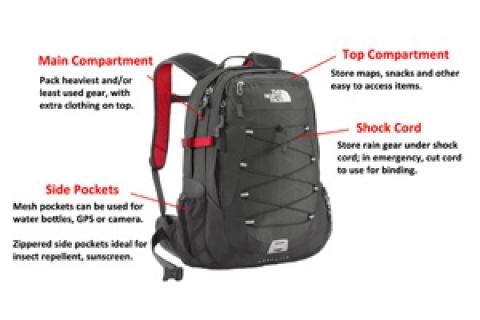
If you're a gear junkie like me, you know that rummaging through your daypack is part of the game. Although, a bit of organization of gear, including the dedication of specific pockets or pouches per item, helps maintain a pleasant relationship with your trusty ol' daypack.
I typically carry an extra camera lens in my daypack, which must be located quickly if a cover photo image appears before my eyes. If I spend unnecessary time fumbling around in the multiple daypack compartments in search of that lens, the shot will be nearly or completely lost. Daypacks have come along way over the last couple decades, and they hold a lot of gear. So organizing it for sanity is a must.

1. The main compartment, usually the biggest, is best reserved for heaviest gear and/or the least used. The first-aid kit fits in the main compartment nicely, although not heavy, but it's least used (hopefully so). An extra bottle of water or two anchors the big section's bottom. Extra clothing fits on the top of the heavier stuff, to fill the remainder of the main compartment, which also keeps the other gear in that part from moving around while moving.
2. The side pockets are within easy reach, even while on the move. On some daypacks, side pockets come in two types: mesh and covered with zipper. The mesh side pockets are ideal for holding a water bottle, a GPS unit or a point-and-shoot camera. Closed side pockets with zipper closures work well for storing insect repellent sprays and tubes of sunscreen. The side pockets should be reserved for often used items so they are easily and quickly accessible.
3. Shock cord configurations attached to the rear of daypacks are often overlooked and not used. But, the shoelaced-looking cord criss-crossed on the exterior of a daypack is perfect for storing rain gear — either wet or dry. The "net", as some hikers have tagged the shock cord arrangement, also holds extra gear that may not fit in the main compartment, but be sure the item stored by the net will not slip out. In an emergency, the cord can be cut from the daypack and be used for binding.
4. The top pocket (some daypacks have two top pockets together) holds often used items such as maps and field guides that need to be kept dry. I also store a couple snack bars in the top compartment, and refuel the body while stopping to review my map.
5. Many daypacks now include a hydration system involving a removalable bladder and liquid delivery tube. When shopping for a new daypack focused on ones with hydration systems, keep in mind the bladder will expand when filled with water — this means less storage space in the main compartment, so more exterior pockets the better. An organized daypack holds a lot of stuff, and the more it is all easily located when needed, the better.
- 3806 views

